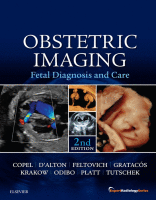Physical Address
304 North Cardinal St.
Dorchester Center, MA 02124

Introduction The choroid plexus is a vascular convolute, consisting of epithelial cells (a type of microglia), fenestrated blood vessels, and stroma, which lie in the ventricular system of the brain. It is the main source of cerebrospinal fluid (CSF) and…

Introduction The fetal spleen is an important center of hematopoiesis until the late fetal period. In postnatal life, the function of the spleen is mainly as an immune organ, with lymphocyte and monocyte production continuing throughout adult life. During fetal…

Introduction Sacrococcygeal teratoma (SCT) is the most common tumor in newborns. Fetal SCT diagnosed in utero is associated with a 50% risk of preterm delivery, a mortality rate of 15% to 35%, and a morbidity rate of 12% to 68%.…

Introduction Megacystis-microcolon-intestinal hypoperistalsis syndrome (MMIHS) is a rare and severe condition that is characterized by functional intestinal obstruction with dilated small intestine, microcolon, malrotation, decreased or absent bowel movement, and, prenatally, a massively enlarged nonobstructive urinary bladder often associated with…

Introduction Intraabdominal solid masses and cystic lesions are not commonly identified during the routine 20-week anomaly ultrasound (US) scan and are uncommon findings at later gestations. However, intraabdominal masses occasionally are seen as an incidental finding during a third-trimester US…

Introduction Structural fetal hepatic anomalies include tumors (usually primary, rarely metastatic), calcifications, cysts, hepatomegaly, and biliary anomalies. Fetal biliary anomalies are discussed in Chapter 25 . Many of these conditions can be diagnosed prenatally by ultrasound (US). Hepatic Tumors, Calcifications,…

Introduction Incomplete formation of the fetal diaphragm early in gestation results in a diaphragmatic defect allowing abdominal organs to herniate into the chest. These organs compete for space with the growing lungs, leading to inadequate pulmonary development and to respiratory…

Introduction The fetal intestinal tract can be altered by numerous pathologic processes. Typical ultrasound (US) findings of bowel obstruction are dilated bowel loops in the fetal abdomen proximal to the obstruction. Although large bowel dilatation occasionally can be observed, most…

Introduction The diagnosis and detection of some forms of bile duct disease have become possible with routine prenatal ultrasound. However, it remains difficult to offer a specific diagnosis or even prognosis in most cases. The most common finding is probably…

Introduction Different organ systems can give rise to abdominal cysts that can be detected on prenatal ultrasound (US) ( Table 24.1 ). Depending on the location, gestational age, gender, and US appearance of the cyst, a limited differential diagnosis or…